We tested every major Japan eSIM provider in Tokyo subways, rural onsen towns, and emergency situations. Here’s what actually works.
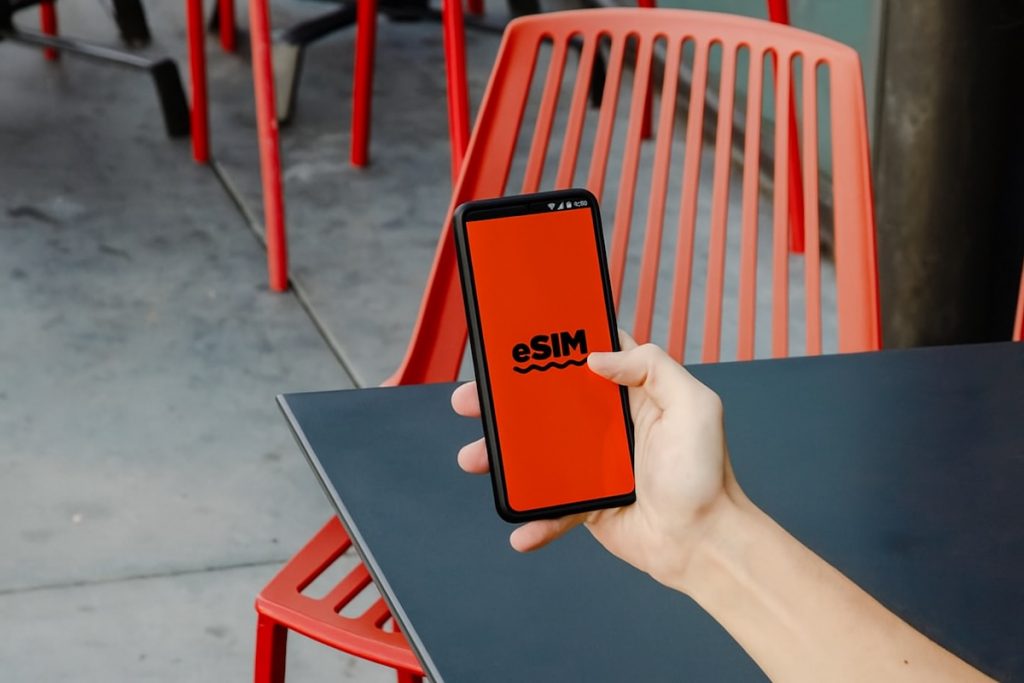
Picture this: You just arrived in Tokyo and are standing in Shibuya Station during rush hour, trying to find your way in the busiest train intersection, but your phone shows zero bars. Or you’re hiking in Hakone with breathtaking views of Mount Fuji, but your “global” eSIM can’t find a signal, and you can’t share the live moment with your family abroad.
You have access to some of the world’s most advanced cellular infrastructure in Japan, and these problems aren’t due to Japan’s networks; it’s because of choosing the wrong connectivity provider for your specific travel needs.
Most guides treat all Japan eSIMs as essentially the same. They focus on price comparisons and ignore fundamental differences in network access, coverage areas, and emergency capabilities. This often leads to frustrated travelers who discover their budget eSIM works great in central Tokyo but completely fails during day trips to Nikko’s temples, in train tunnels between cities, or at remote onsen towns where you need connectivity most.
In this guide, we take a different approach. Instead of just features, we identify the specific problems travelers face in Japan, and share with you exactly which Japan eSIM works for each scenario.
1. Journey Japan eSIM
Best for: Reliable coverage everywhere in Japan without complexity
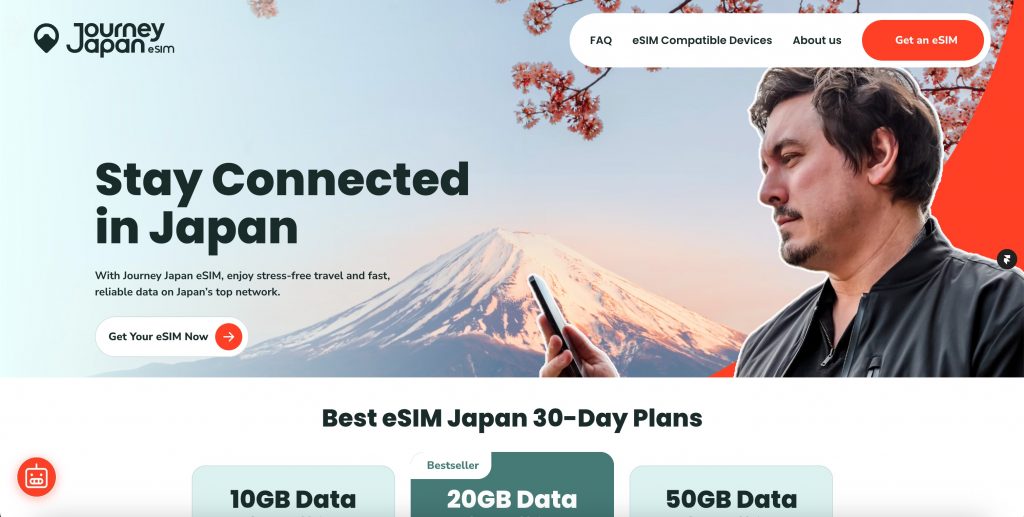
Journey Japan eSIM was started by Chris Broad, the English YouTuber behind the massively popular “Abroad in Japan” channel with over 2.5 million subscribers. After living in Japan for over a decade—first as an English teacher in rural Yamagata, then as a full-time content creator—Chris experienced firsthand the connectivity challenges that plague travelers, especially in the remote locations he frequently explores for his documentaries and travel series.
While most Japan eSIM providers compete on price or worldwide coverage, this one does neither. Instead, it works exclusively with NTT Docomo—Japan’s most reliable network—and has plans only for Japan. The trade-off is obvious: you can’t use it in 150 countries. The payoff is less so: your connection actually works in rural Hokkaido and mountain onsen where cheaper alternatives fail.
What makes it different:
- Docomo network exclusivity – Japan’s most reliable carrier with superior rural coverage that reaches 99.9% of populated areas
- Japan-only focus – Three simple 30-day plans designed around actual Japan trip lengths, not global one-size-fits-all packages
- Local expertise – Built by Japan travel experts who understand real connectivity needs, from rush-hour train tunnels to remote mountain onsen
- Travel perks included – Curated partner discounts across Japan add genuine value beyond connectivity
Journey Japan eSIM delivers excellent performance in Tokyo, Osaka, and Kyoto urban areas with consistent and fast speeds. More importantly, it maintains reliable coverage in rural Hakone mountain areas, Nara countryside, and remote parts of Hokkaido where competing providers failed. Even in challenging locations like JR tunnel sections between cities and deep subway platforms in Tokyo, it keeps working while cheaper alternatives drop out completely.
Setup: Activation code, typically activates within 5 minutes
Plans: 10GB ($19), 20GB ($29), 50GB ($49); all 30-day periods
Journey Japan eSIM stands out by focusing exclusively on what works in Japan rather than trying to be everything to everyone. For travelers who want reliable connectivity without technical headaches, it’s the best Japan eSIM that delivers on its promises, and backed by someone who’s been in your shoes and built exactly what he needed.
2. Sakura Mobile
Best for: Human support and flexibility for Japan travel
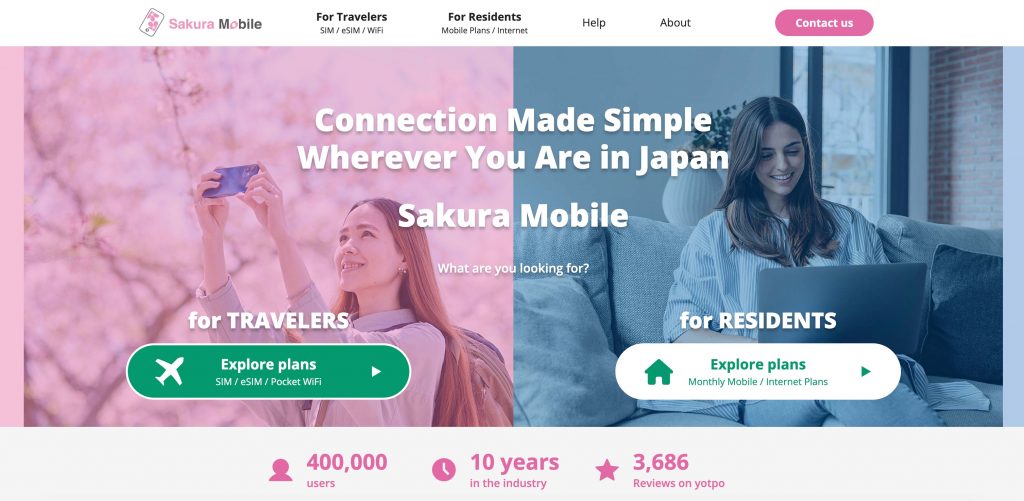
Sakura Mobile is a Tokyo-based company that is known mostly for their exceptional customer service and flexible plans that adapt to your specific needs. The company runs exclusively on NTT Docomo’s network, giving it the same rural coverage advantages as premium providers.
Sakura’s real differentiator is flexibility. Their plans range from single days up to 90 days, with both unlimited and fixed-data options. Trip extending unexpectedly? Call them. Need a different plan mid-journey? They’ll sort it out. Device compatibility issues? They’ll upgrade you to a physical SIM or pocket WiFi immediately.
What makes it different:
- Year-round English support – Real humans available 365 days, not chatbots or email delays
- Maximum flexibility – Plans from 1-90 days with both unlimited and fixed-data options
- Local presence – Actual offices in Japan with airport pickup counters and extended hours
- Problem-solving focus – Will upgrade you to different hardware if compatibility issues arise
- Docomo network reliability – 99% coverage using Japan’s largest network infrastructure
Sakura Mobile delivers solid performance with top of the line internet speed, and reliable 4G connectivity throughout Japan. One downside of their unlimited plans include a fair usage policy that throttles speeds after 3GB of daily usage.
Plans: Unlimited data from ¥4,500 ($28) for 8 days up to ¥24,000 ($149) for 90 days; fixed data plans priced by calendar dates (varies by season)
Setup: QR code via email, must install after arriving in Japan for 4G plans, can pre-install 5G plans
Sakura Mobile works best for travelers who value peace of mind over rock-bottom prices. The premium you pay gets you the safety net of human support when things go wrong—something that’s worth far more than saving a few dollars when you’re standing lost in Shibuya Station.
3. Airalo
Best for: Fast speed and performance in central locations
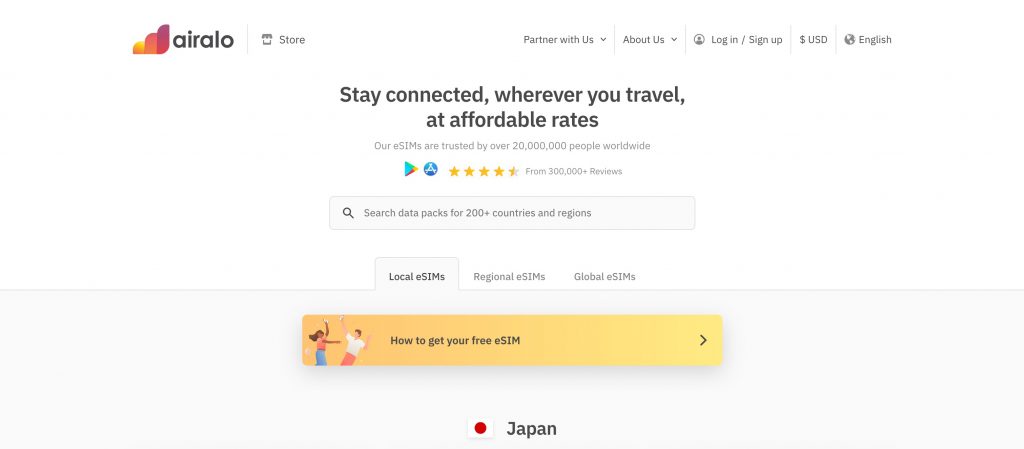
Airalo is an international eSIM provider with scale, speed, and global reach as a priority. If you’re visiting Japan as part of a larger trip or frequently travel internationally, Airalo can be a good choice.
Airalo’s average download speeds average more than 100 MBPs where network availability is strongest. Websites load instantly, video calls run flawlessly, and YouTube never buffers. If you’re the type who gets frustrated waiting three seconds for Instagram to refresh while exploring Shibuya or Ginza, this is your service.
Airalo connects to both KDDI au and SoftBank networks. Their “Moshi Moshi” Japan plans cover everything from quick weekend trips to month-long adventures, with the flexibility to top up data mid-trip if you burn through your allocation uploading too many shrine photos. More importantly, you can manage multiple country eSIMs from the same app, which makes it ideal for travelers hitting Japan, South Korea, and Thailand in the same trip.
However, Airalo has rural coverage gaps which means it might not always be ideal for off-the-beaten-path adventures in Japan’s countryside. Additionally, because it’s an international company, they do not have great local support or good response times when issues arise. Their VPN-like routing could also cause compatibility issues with some Japanese retailers like amazon.jp or Bic Camera.
What makes it different:
- Speed performance – Consistently delivers the fastest download speeds in real-world testing in major cities
- Global marketplace leader – Over 10 million users across 200+ countries, with regional and global plans available
- Multi-country convenience – Single app manages eSIMs for multiple destinations, perfect for regional travel
- Dual network access – Connects to both KDDI au and SoftBank for better urban coverage
- Flexible top-ups – Can add more data mid-trip without buying a new plan
Setup: Instant QR code delivery via app, typically activates immediately upon arrival
Plans: 1GB/7 days ($4.50), 2GB/15 days ($6.50), 3GB/30 days ($8.50), 5GB/30 days ($11.50), 10GB/30 days ($18), 20GB/30 days ($26)
Airalo works best for urban-focused travelers who value fast speeds over comprehensive coverage. If you’re planning to stay in Tokyo, Osaka, and other major cities where network infrastructure is strongest, the excellent performance justifies the cost.
4. Ubigi
Best for: Budget-conscious travelers who want advanced multi-network platform
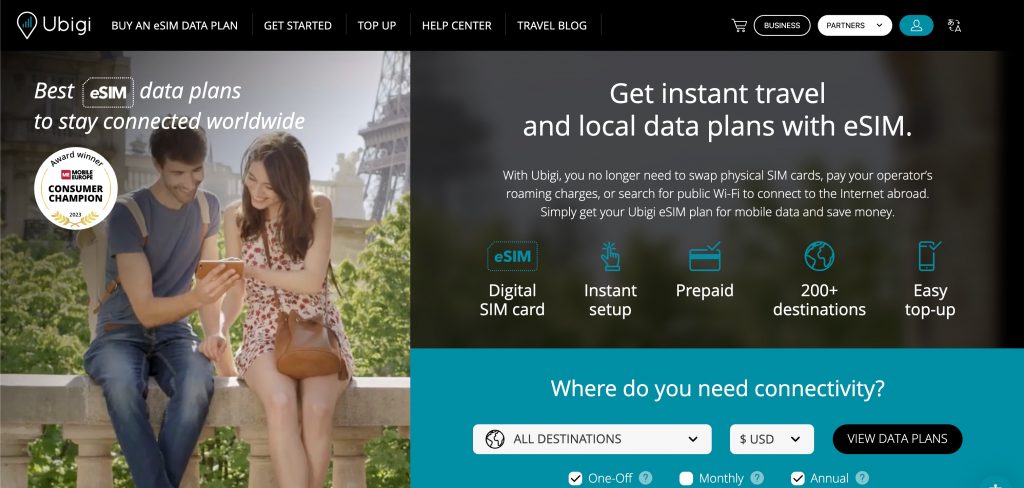
Owned by Transatel, a French telecom company that’s part of NTT Group (the same parent company behind NTT Docomo), Ubigi has really good enterprise infrastructure that deliver consistent performance at budget-friendly prices. Ubigi runs connectivity for BMW, Airbus, and major automotive manufacturers in Japan.
The company connects to NTT Docomo’s network in Japan, which gives the same coverage foundation as premium providers but at significantly lower prices. As a full MVNO (Mobile Virtual Network Operator) with its own core network, it experiences fewer disconnections and lower latency than resellers who rely on third-party infrastructure.
However, Ubigi’s enterprise focus shows in areas that matter to travelers. Users with lack of technical knowledge can find their setup processes confusing and their support relies primarily on help tickets rather than live chat, which could be frustrating when issues arise during travel. However, the service maintains consistent 4G connectivity throughout urban Japan, though you might find slower connections in rural areas.
What makes it different:
- Enterprise-grade infrastructure – Full MVNO with proprietary core network reduces disconnections and latency
- NTT Group backing – Owned by the same parent company as NTT Docomo, ensuring reliable Japan partnerships
- One eSIM convenience – Keep the same profile and top up for different destinations
- Flexible plans – One-time, monthly, and annual options for different travel patterns
Setup: Email QR code delivery within seconds, typically activates immediately upon arrival in Japan
Plans: Fixed data: 500MB-60GB ($3-$260), 1-365 day validity; Monthly: 5GB recurring plans; Unlimited: 7-30 day options with fair use policy
Ubigi works best for budget-conscious travelers who prioritize value over premium support. If you’re comfortable troubleshooting technical issues yourself and want enterprise-level infrastructure at consumer prices, Ubigi an excellent choice.
e over premium support. If you’re comfortable troubleshooting technical issues yourself and want enterprise-level infrastructure at consumer prices, it’s an excellent choice—just don’t expect white-glove customer service when things go wrong.
5. Holafly
Best for: Data-heavy users who want unlimited plans
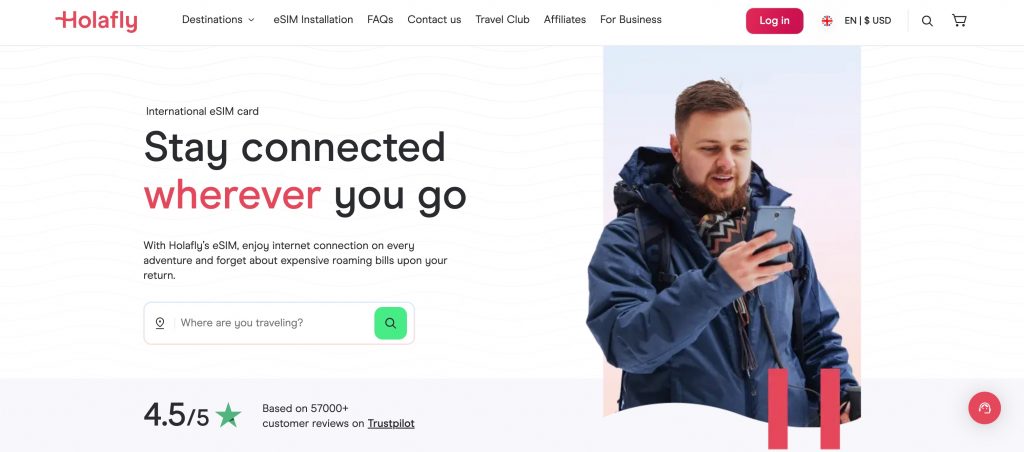
Holafly operates as the “unlimited everything” provider in Japan’s eSIM market. Their Japan plans connect to KDDI au network and start at $6.90 for 1 day, scaling up to custom periods of your choosing. The appeal is obvious: stream videos, upload Instagram stories, and video call home without constantly checking your remaining gigabytes. For travelers who hate rationing connectivity, using Holafly can remove the anxiety of running out of data mid-trip.
However, Holafly’s “unlimited” comes with important caveats. We’ve heard from several users about speed throttling after 2-3GB daily usage, dropping connections to unusable levels despite the premium pricing—often 2-3x more expensive than capped alternatives.
Holafly has a decent customer service with 24/7 chat support that actually responds like humans rather than bots. Setup is straightforward via QR code or their mobile app, and they offer a generous 6-month refund policy for unused eSIMs. Regional plans let you use the same eSIM across multiple countries, making it convenient for Asia-hopping trips.
What makes it different:
- Unlimited-only approach – All plans offer unlimited data, eliminating usage monitoring stress
- Flexible duration – Choose exactly how many days you need, from 1 to 90 days
- Superior customer service – 24/7 human support via chat, WhatsApp, and email with quick response times
- Hotspot support – Share data with other devices (500MB daily limit)
- Regional convenience – Single eSIM works across multiple Asian countries
Setup: Instant email QR code delivery, activates automatically upon arrival
Plans: Unlimited data: 1 day ($5.99), 10 days ($36.90), 25 days ($67.90), 50 days ($95.90), 90 days ($138.90)
Holafly works best for travelers who need unlimited data and don’t mind paying premium prices for peace of mind. However, if you’re a heavy user who might trigger their throttling policies, the higher cost may not deliver the unlimited experience you’re paying for.
6. Saily
Best for: Security-conscious travelers who want built-in privacy features
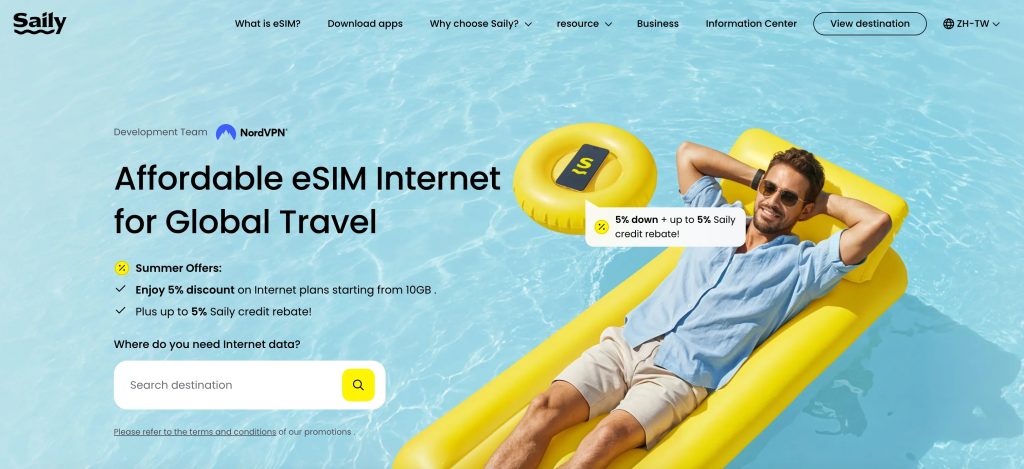
Created by Nord Security, the company behind NordVPN, Saily launched in 2024 as a data-only eSIM service that combines reliable global connectivity with cybersecurity expertise. The service uses 1GLOBAL as its network infrastructure provider, a UK-based telecommunications company that operates a unified global network with partnerships across major carriers worldwide.
In Japan, Saily connects to NTT Docomo’s network, which provides extensive coverage across the country including rural areas, though extremely remote locations might have limited service. What sets Saily apart from typical eSIM providers is its integration of Nord Security’s privacy technology directly into the service. Each plan includes built-in security features like ad blocking, web protection against malicious sites, and a virtual location tool with access to 115+ server locations worldwide.
However, Saily’s focus on simplicity means some limitations for certain travelers. The service is data-only with no voice calling or SMS capabilities, requiring users to rely on internet-based apps like WhatsApp or Skype for communication. Additionally, you must download the Saily iOS or Android app to activate your eSIM, unlike other providers that offer website-based activation.
What makes it different:
- Security-first approach – Built-in VPN-like virtual location, ad blocker, and web protection powered by Nord Security’s technology
- Auto-activation convenience – Plans activate automatically when you reach your destination or after 30 days of purchase, whichever comes first
- Premium network access – Partnerships with leading carriers rather than budget operators ensure reliable coverage and speeds
Setup: Instant QR code delivery via email, with automatic activation upon arrival in Japan when you enable roaming
Plans: Fixed data: 1GB/7 days ($3.99), 3GB/30 days ($6.99), 5GB/30 days ($9.99), 10GB/30 days ($15.99), 20GB/30 days ($22.99);
Saily works best for security-conscious travelers who prioritize value and privacy. If you want built-in privacy features, automatic activation, and competitive pricing, Saily offers excellent value for Japan travel.
7. Mobal
Best for: Long-term travelers who need a real Japanese phone number
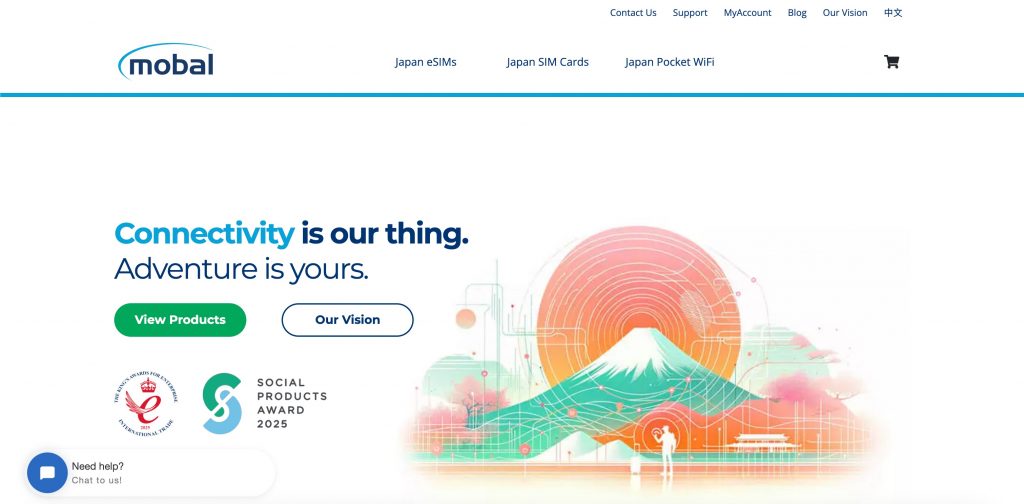
Mobal is one of the longest-established foreign SIM providers in Japan, with deep local expertise and infrastructure. What sets Mobal apart is its unique offering of real Japanese phone numbers (070, 080, or 090 prefixes) with both Voice+Data and data-only eSIM options, making it essential for anyone working or studying in Japan where virtual numbers aren’t accepted by institutions. Due to Japan’s strict regulations around phone numbers, Voice+Data eSIMs require ID verification and can’t be emailed.
Mobal’s eSIMs are native to Japan rather than roaming services, which means better reliability, no battery drain from roaming, and faster speeds without latency issues. The service connects to NTT Docomo’s network, and offers 99% coverage across Japan including rural areas, and supports unlimited data after your allocation with reduced speeds.
Mobal’s comprehensive service might be complex for some. Access codes must be posted to your overseas address or picked up in person in Japan. Unlike competitors, Mobal doesn’t offer a mobile app, relying instead on QR code activation and web-based management.
What makes it different:
- Real Japanese phone numbers – Only provider offering genuine 070/080/090 numbers essential for working/studying in Japan
- Native Japan infrastructure – No roaming means better reliability, battery life, and speeds compared to foreign eSIMs
- Flexible contract-free plans – No minimum contract period or cancellation fees, monthly plans from 1GB to 30GB
Setup: Data-only: Email with service link in 5 minutes, QR code ready in 10 minutes; Voice+Data: Requires advance application, ID upload, and postal delivery
Plans: Data-only: 3-100GB for 8-31 days ($15-$70); Voice+Data: ¥2,970 setup + monthly plans ¥1,650-¥4,378 (1-30GB); Speed: Average 24.76Mbps download on NTT Docomo network
Mobal works best for long-term travelers, expats, or anyone needing voice calling capabilities in Japan. If you require a real Japanese phone number for banking, employment, or institutional purposes, Mobal is your only eSIM option.
8. Nomad
Best for: Multi-country travelers who want reliable dual-network coverage and flexible data options
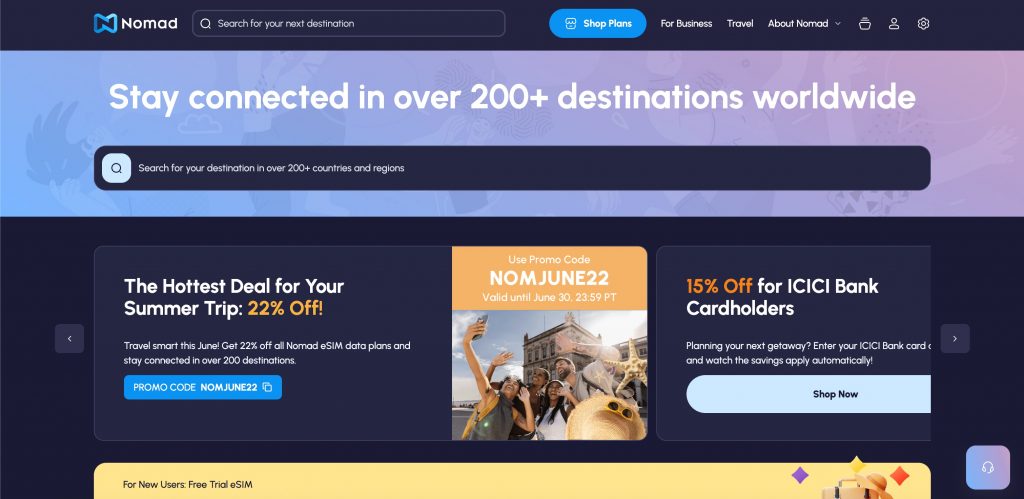
Nomad operates as a global eSIM marketplace offering data plans in 200+ destinations, with comprehensive coverage specifically tailored for frequent travelers. In Japan, Nomad’s unique advantage is dual-network access to both Softbank and KDDI—two of Japan’s largest carriers—providing redundant coverage that automatically switches between networks for optimal connectivity.
The service offers exceptional flexibility with Day Plans (500MB-3GB) for short trips and Regular Plans (1-50GB for 30-45 days) for extended stays, with competitive pricing starting at $0.98/GB. Daily plans include throttled data continuation at 512kbps after high-speed allocation, while regular plans support add-on purchases for seamless data top-ups.
However, Nomad’s marketplace model means some limitations compared to native providers. All plans are capped at maximum 100GB with no unlimited options, and global plans can be significantly more expensive at $12-25/GB compared to regional alternatives. Customer service operates exclusively in English through forms and email rather than live chat, which may slow resolution times.
What makes it different:
- Dual-network redundancy – Automatic switching between Softbank and KDDI networks ensures coverage in all areas
- Flexible data options – Day plans with throttled continuation or regular plans with add-on capability
- Multi-country optimization – Regional plans like CN-JP-KR ($1.35/GB) and APAC ($1.44/GB) for multi-destination trips
- Instant activation – 3-minute setup process with automatic network connection upon arrival
Setup: Instant QR code via app or email, automatic activation when connecting to Japan networks, install up to 60 days before travel
Plans: Fixed data: 500MB-50GB ($2.50-$170), 1-365 day validity; Daily caps with 512kbps continuation; Regional options for multi-country travel
Nomad works best for frequent travelers visiting multiple countries who prioritize network reliability and flexible data management. If you’re traveling multiple Asian countries or need good coverage with automatic network switching, Nomad offers excellent value and convenience.
Japan eSIM FAQs
Which phones support eSIM in Japan?
Most smartphones released after 2018 include eSIM capability, but there are some important exceptions to be aware of. The iPhone XS, XR, and all newer models support eSIM, with US-purchased iPhone 14 and 15 models being eSIM-only devices. Samsung Galaxy S20 series and newer phones work seamlessly, as do Google Pixel devices starting from the Pixel 3. Other major brands like OnePlus, Xiaomi, Oppo, and Motorola have included eSIM support in their recent flagship models.
The easiest way to check compatibility is to look in your phone’s settings under Cellular (iOS) or Network & Internet > SIMs (Android) to see if you have an “Add eSIM” or “Download SIM” option.
How do I know if my phone is unlocked?
Your phone must be carrier-unlocked to use any third-party eSIM provider, and this is often where travelers encounter their first hurdle. If you purchased your phone directly from a wireless carrier like Verizon, AT&T, or T-Mobile, there’s a good chance it’s locked to their network. These carriers typically lock phones to prevent customers from switching providers before fulfilling contract obligations.
However, if you bought your device as “unlocked” or “SIM-free” from retailers like Amazon, Best Buy, or directly from Apple, it should work with any eSIM provider. Most carriers will unlock your phone for free once you’ve met your contract terms, and some are required by law to unlock devices after a certain period. The process usually takes 24-48 hours and can be initiated through your carrier’s website or customer service.
Can I use eSIM while keeping my home number active?
Modern smartphones have features to manage multiple SIM profiles simultaneously. You can keep your primary SIM card active for receiving calls and texts from home while using the Japan eSIM exclusively for data. This setup prevents expensive roaming charges while ensuring you don’t miss important communications.
The key is configuring your phone’s cellular settings correctly. You’ll want to designate your Japan eSIM as the primary data line while keeping your home SIM for voice and messaging. Most phones make this process straightforward through their cellular or network settings, allowing you to customize which SIM handles which functions.
How much data do I need for my Japan trip?
Data consumption varies based on how you use your phone while traveling. Light users who primarily rely on hotel WiFi and only use mobile data for maps, messaging, and occasional photo uploads typically consume 1-3GB per week. This covers essential navigation with Google Maps, staying connected via WhatsApp or Telegram, and sharing highlights on social media.
Moderate users who frequently browse social media, stream music during commutes, and make regular video calls home usually need 5-10GB per week. Heavy users who stream videos, work remotely, use their phone as a hotspot for other devices, or upload lots of high-resolution photos and videos should budget 15-20GB or more per week. Most tourists fall into the moderate category, finding 5-7GB sufficient for a week-long trip in Japan with balanced usage.
Do Japan eSIMs include phone calls and SMS?
The vast majority of Japan eSIM plans are data-only services, which means they don’t include traditional voice calling or SMS capabilities.
For situations requiring traditional phone calls—such as calling restaurants for reservations or contacting tour operators—services like Google Voice or Skype can place calls to regular phone numbers using your data connection. If you need Voice+Data eSIM plan with genuine Japanese phone number, these require identity verification and physical delivery due to Japanese telecommunications regulations.
What happens when I run out of data?
Data exhaustion policies vary significantly between eSIM providers. Most providers implement hard caps, meaning your internet access stops completely once you’ve consumed your allocation. You’ll need to purchase additional data packages to restore connectivity.
Other providers reduce your connection speed to 200-512kbps after you’ve used your high-speed allocation. While significantly slower, this throttled connection still allows basic functions like messaging, maps, and email. Most modern eSIM apps include usage monitoring and allow easy top-ups when you’re running low, often with push notifications to warn you before hitting your limit.
Can I share my eSIM data with other devices?
All major eSIM providers support mobile hotspot functionality, allowing you to share your connection with tablets, laptops, and other travelers’ devices. However, sharing data accelerates consumption significantly—streaming video on a laptop can consume several gigabytes per hour. If you’re traveling with family or a group requiring multiple connected devices, consider whether individual eSIMs, a pocket WiFi rental, or higher data allowances make more sense.
Some travelers designate one person’s phone as the group’s primary hotspot device, purchasing larger data packages specifically for sharing. This approach works well for families but requires careful data monitoring to avoid unexpected overages during your trip.
Will I get 5G speeds in Japan?
Most travelers will rely primarily on 4G LTE networks while in Japan, which actually proves to be more advantageous. While some eSIM providers offer 5G capabilities, it’s often unnecessary for typical travel activities and comes with significant drawbacks. 5G connections drain battery substantially faster than 4G, which can be problematic when you’re out exploring all day.
Additionally, phones frequently switch back to 4G LTE automatically to preserve battery life and maintain stable connections. 4G speeds typically range from 50-100+ Mbps in urban areas, more than sufficient for streaming, video calls, and all typical smartphone usage. Rural areas may see slower speeds but generally maintain reliable connectivity for essential functions.
Does Japan have data speed restrictions?
Japan enforces a Fair Usage Policy (FUP) designed to ensure equitable network access for all users. This policy can affect both “unlimited” plans and regular data allowances during periods of network congestion or exceptionally heavy usage. Typically, users consuming more than 2-5GB per day may experience speed throttling, though exact thresholds vary by carrier and network conditions.
The FUP primarily impacts users engaged in sustained high-bandwidth activities like continuous video streaming or large file downloads. Normal tourist usage—including navigation, social media, messaging, and moderate video consumption—rarely triggers these restrictions. Understanding this policy helps set realistic expectations, especially for travelers purchasing “unlimited” plans that may have practical daily limits.
When should I buy my Japan eSIM?
Getting a Japan eSIM 1-7 days before departure can provide sufficient time to install the eSIM profile and test the setup process while you have reliable internet access. This timeline allows you to contact customer support if installation issues arise and ensures you’re not scrambling with technical problems at the airport.
Installing the eSIM profile before traveling is not only possible but recommended. Installation simply adds the carrier profile to your phone without starting your data plan. Actual activation typically occurs automatically when your phone connects to Japanese networks upon arrival, meaning early installation doesn’t waste any of your purchased data allowance.
Are eSIMs cheaper than roaming?
eSIMs deliver substantial savings compared to traditional carrier roaming, often reducing costs by 50-80% while providing better service control. Most US carriers charge $10-12 per day for international roaming, which can quickly accumulate during longer trips. A seven-day Japan vacation would cost $70-84 in roaming fees alone, not including overage charges for excessive usage.
Japan eSIMs typically cost $4-8 per day for 1-5GB of data, depending on your chosen provider and plan size. This represents significant savings while often delivering faster speeds and more predictable pricing. eSIMs also eliminate the surprise bills that sometimes accompany international roaming, as you pay upfront for a specific data allocation with clear terms and limitations.
How do Japan eSIM prices compare to local SIM cards?
Local Japanese SIM cards generally offer better value for extended stays, typically costing 20-50% less than international eSIM plans. However, this cost advantage comes with significant convenience trade-offs that many travelers find prohibitive. Purchasing local SIMs requires airport queues, language barriers, cash payments, and often complex registration procedures.
eSIMs provide instant activation, English-language customer support, advance purchase capability, and the ability to maintain your primary phone number simultaneously. For trips shorter than 2-3 weeks, the convenience premium is usually worthwhile. Longer stays may justify the extra effort required for local SIM cards, particularly for budget-conscious travelers or those requiring maximum data allowances.
Can I get a Japanese phone number with an eSIM?
Obtaining a genuine Japanese phone number with eSIM has additional requirements and costs.
The process involves identity verification, document uploads, and either postal delivery to your overseas address or in-person pickup in Japan. You’ll also need to pay setup fees plus monthly service charges, which makes it significantly more expensive than data-only alternatives.
Related Articles
Mario Movie Mistakenly Plays Wrong Movie, Children Cry and Chaos Ensues!
Viewers excited for the Mario Movie were in for a surprise when the wrong movie played on accident, scaring some younger moviegoers.
Will wearing a mask become a new cultural norm in Japan?
Wearing masks in Japan has become a part of daily life for over three years. Will it continue?





